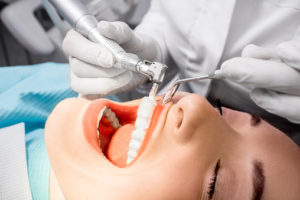
The surface appearance of a person’s teeth and gums are an important confident booster. Over time the surface of a tooth can become dull. The daily routine of eating, drinking, and habits can cause the tooth enamel to turn yellowish or become stained. At some point, patients may consider having their teeth professionally polished for cosmetic reasons. Having your teeth polish has its benefits and drawbacks. Before considering whether polishing is appropriate, you should consult with your dentist first.
What is dental polishing and recommendation for polishing?
Tooth polishing smooths the surfaces to restore the glossy and lustrous shine. Polishing removes the soft deposits, plaque, biofilms, and stains from the surface of a tooth that brushing cannot. However, if too much polishing is done, this can have a detrimental effect on the surface tooth structure, causing premature wear. Importantly, the thin superficial fluoride layer deposits that help strengthen the tooth is effectively removed. For this reason, it is not advised to perform tooth polishing routinely but only done selectively based on patients need.
When tooth polishing is performed, it will generally fall into one of the three categories:
Therapeutic polishing
When therapeutic polishing is performed, the dentist will clean and polish the root surface. This can be done as periodontal therapy to remove and reduce bacterial buildup at the root surface.
Coronal or cosmetic polishing
As the name implies, cosmetic polishing is a procedure to remove stains and plaque on the surface of the tooth. This process will restore the shine and luster of the tooth surface. An abrasive dental agent is used to remove a thin coating of the tooth.
Selective polishing
When a tooth is selectively polished. Your dental healthcare provider will only polish your teeth if there is a justified therapeutic reason. For example, after your dentist has performed a scaling and oral debridement and visible stains are still present, this would justify the need to polish the stained area. Polishing and cleaning of other tooth surfaces will be excluded. In other words, endogenous stains cannot be polished out. However, most extrinsic stains can be removed by scaling and polishing.
What to expect during tooth polishing.
During the tooth polishing procedure, your dentist will carefully use the proper technique to reduce unnecessary abrasion of the enamel. The tooth polishing objective will dictate which type of abrasive agent your dentist will use. A more abrasive agent will be selected to remove biofilms and stains. A tooth’s luster and shine are restored by using a finer abrasive to minimize wear.
If you have questions about dental polishing, be sure to contact California Dental Group at 800-407-0161.

